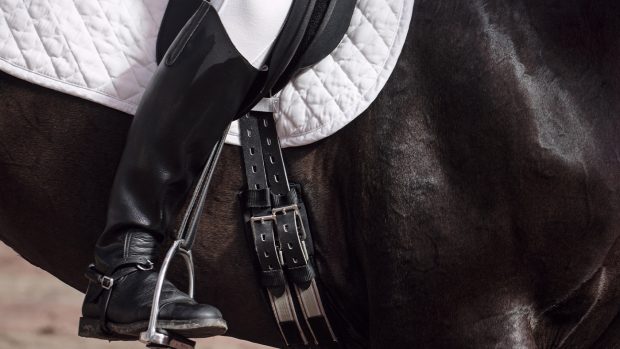There was a time when a girth was simply a strap under the tummy to stop the saddle sliding off, but there is now a bewildering number of types of girth on the market.
Your choice of girth will partly be dictated by your saddle’s billet straps. GP and traditional English saddles usually have short straps, requiring a longer girth; while dressage or monoflap saddles need shorter girths to attach to straps which fasten below the saddle flap (so as not to interfere with the lower leg position). Whatever length the girth, like any other piece of tack, it must fit your horse correctly, as it will affect his comfort and therefore way of going.
Signs you may be using the wrong type of girth include:
- your horse has sores in the girth area
- your horse flattens back his ears when you cinch up or bares his teeth
- your horse swishes his tail when you cinch up
- your girth is on the penultimate or top hole on both sides
- your horse seems uncomfortable in front during exercise
Types of girth
Girths come in a variety of shapes, sizes and materials, and there will be one out there to suit your horse and his saddle.
Long girths
These fit most GP or traditional English saddles. Here are the main options:
- Straight girth: usually made from a breathable cushioned web fabric, with no shaping, this is an affordable all-purpose girth
- Contoured girth: these are shaped for freedom around the elbows and are usually made from an anti-chafing cushioned fabric to prevent chafing, such as the Shires Anti-Chafe Contour Girth. They are usually available with elastic at both ends to help even pressure and prevent pinching
- Anatomic girth: even more shaped than the contoured girth, these are specifically designed for jumping, providing maximum space behind the elbows and therefore less restriction on the forelegs. This should give the horse increased stride length and freedom in the air. The more high-tech versions have additional details to absorb pressure and improved comfort, such as the Lemieux Gel-Tek Anatomic Curve Jumping Girth, which has gel pockets
- Fleece-lined girth: the side of the girth touching the horse’s belly is covered with a soft, usually synthetic woollen material, which helps prevent sores and rubs. The QHP Ontario has three rings so that support reins can be attached if required. It is also possible to buy a sheepskin sleeve to fit over your regular girth to prevent rubbing
- Atherstone girth: a traditional leather girth, often cushioned to provide a high level of comfort. They are often contoured and elasticated, such as Shires Blenheim Leather Atherstone
- String girth: these were all the rage for 1980s Pony Club children, but the older stringy prototype tended to pinch and chafe. Modern versions, such as Shires Busse String Girth or the Stübben Cord Girth, are made of flat synthetic fabric and flex with the horse’s movement. They can be suitable for horses with a difficult saddle position
- Neoprene girth: designed to reduce friction and sweat build-up so protecting against rubbing and sores
- Memory foam girth: designed to provide ultimate comfort for the horse. These are usually made of memory foam padding, with anti-chafing neoprene and shaped for freedom of movement. Shires’ version features nylon webbing on the outside to prevent over-stretching, while Collegiate’s has a centre D ring for attaching training aids
Short girths

These are used on dressage or monoflap saddles with long billet straps below the saddle flap.
Like the long girths, these come in a variety of shapes and fabrics to suit your horse. Many are shaped to varying degrees, from the ergonomic design of the Mark Todd Dressage Girth Short Padded, to Rhinegold’s Softee Comfort Dressage Girth.
With freedom of movement a priority for competition horses, many anatomical girths are also elasticated to allow for lateral ribcage expansion. Some are elasticated throughout such as Wintec’s Elastic Girth, rather than just near the buckles, aiming to create even pressure.
In terms of the girth’s shape, there is a huge range of designs, from plain straight or contoured to H-shaped or X-shaped.
Stud girths

These can be short or long, depending on the billet straps, and are designed to protect the horse’s belly from his own studs when tucking up his forelegs while jumping. They are usually anatomically shaped to allow freedom of movement, such as LeMieux Gel-Tek Anatomic Curve Stud Girth, and are available in a variety of fabrics, with and without elastic – such as Mark Todd Deluxe Elasticated Stud Girth.
The most important thing is that the saddle stays put and your horse is comfortable, moving freely to the best of his ability. And if a new girth might make the difference, it’s well worth a try…
You may also be interested to read…

11 long girths to cast your eye over

11 stud girths to protect your horse while jumping

Help! My horse has girth galls, what can I do?
Experts give their advice on the cause and treatment for girth sores

7 tips for fitting your horse’s girth correctly
The girth just holds your saddle on, right? Actually, choosing and fitting a girth requires as much careful consideration as

Subscribe to Horse & Hound magazine today – and enjoy unlimited website access all year round
Horse & Hound magazine, out every Thursday, is packed with all the latest news and reports, as well as interviews, specials, nostalgia, vet and training advice. Find how you can enjoy the magazine delivered to your door every week, plus options to upgrade your subscription to access our online service that brings you breaking news and reports as well as other benefits.




